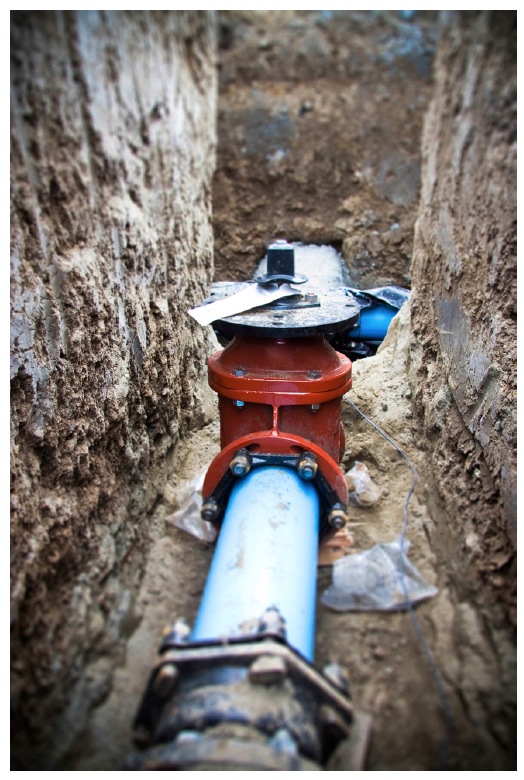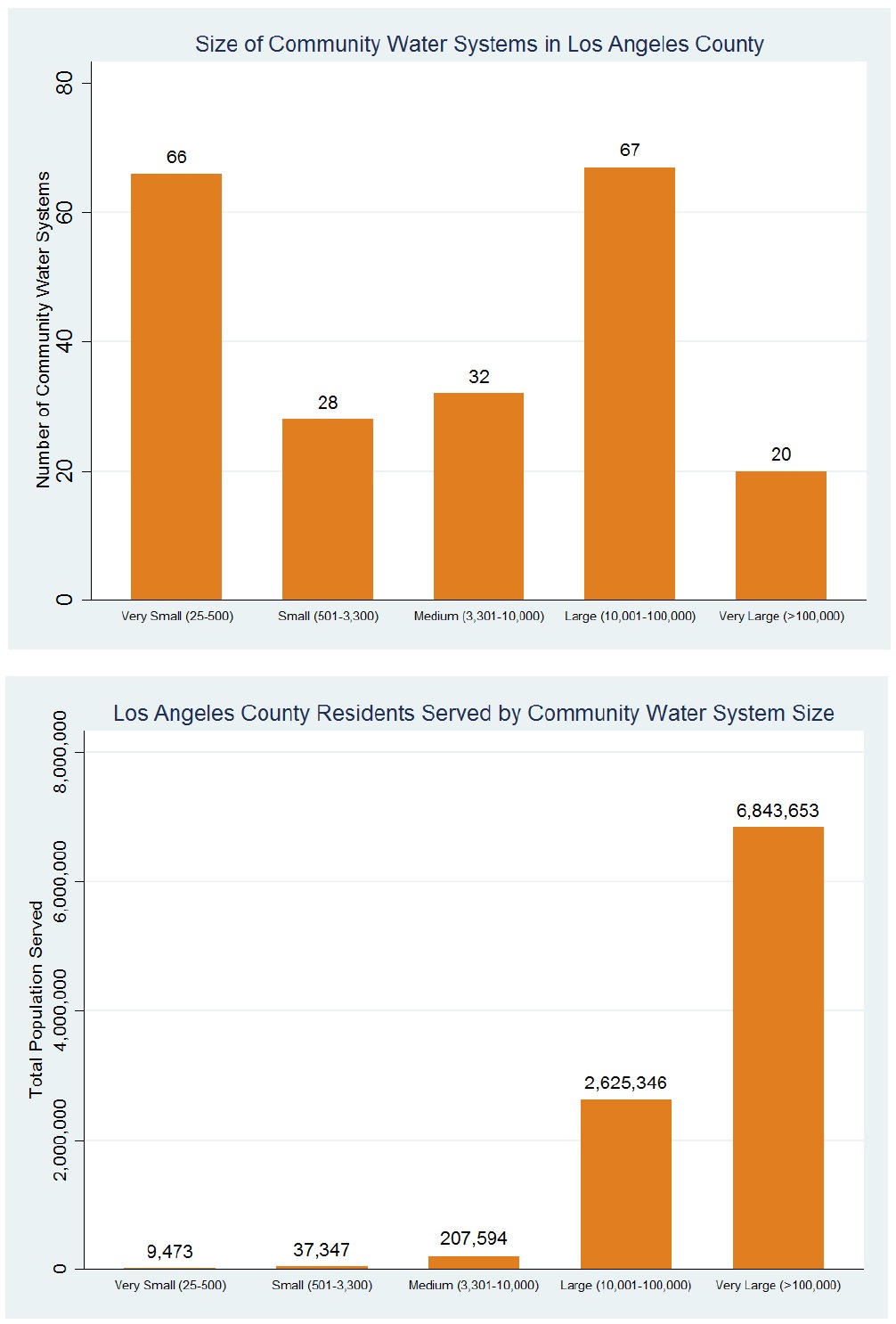UCLA LUSKIN CENTER FOR INNOVATION
Introduction to the Atlas and Policy Guide
Building Blocks of LA’s Water Supply Network
 Despite the essential role water plays in Los Angeles County, surprisingly little is known about our community water systems. Community water systems are the fundamental building blocks of California’s water supply network. These systems are responsible for providing households, businesses, and governments with a reliable supply of clean water at a reasonable price. They are on the front lines of adapting to drought and climate change. They manage lifeline programs for the County’s many low-income households. These systems are the portals through which federal, state, and regional officials implement water policies supporting water supply reliability, conservation, efficiency, affordability, environmental protection, and public health.
Despite the essential role water plays in Los Angeles County, surprisingly little is known about our community water systems. Community water systems are the fundamental building blocks of California’s water supply network. These systems are responsible for providing households, businesses, and governments with a reliable supply of clean water at a reasonable price. They are on the front lines of adapting to drought and climate change. They manage lifeline programs for the County’s many low-income households. These systems are the portals through which federal, state, and regional officials implement water policies supporting water supply reliability, conservation, efficiency, affordability, environmental protection, and public health.
Few people know that Los Angeles County currently has 228 community water systems. Each community water system is mapped in the Gazetteer on page 49. As we show, they vary dramatically in their size, geography, the types of communities they serve, and their technical, managerial, and financial capacities: ranging from a mobile home park of twenty-five residents in Antelope Valley to the Los Angeles Department of Water and Power with nearly four million customers. Every community water system has adopted one of eight governance structures, which are governed by five distinct bodies of state law. Adding to this complexity, smaller water systems are often exempted from statewide water conservation and consumption reporting regulations. As a result, federal and state oversight and knowledge of these community water systems is fragmented and often limited.
By providing this Atlas and Policy Guide we seek to improve policymakers’ understanding of the population of community water systems within Los Angeles County and to provide a data resource for future researchers. This report is the first volume in a three-volume series.
Number of Community Water Systems by Size and Governance Type
The first volume begins by characterizing the number of community water systems by size and governance type. By understanding how many community water systems of each governance type serve the County, we may understand the scope of local impacts when California policymakers change the water, government, public utilities, municipal, or corporations codes. Similarly, by understanding the number of smaller water systems and the populations served by them, we may better appreciate local consequences of exempting these water systems from planning best practices and usage reporting regulations. This analysis recognizes that technical and managerial capacities of water systems vary across system size and governance type—setting the stage for evaluating their ability to adapt to emerging threats and opportunities as well as meet the needs of their vulnerable customers.
Threats and System Vulnerabilities
We characterize several important threats facing community water systems in Los Angeles County. By identifying which water systems are entirely dependent on local groundwater or imported water, we can begin to assess water supply risks. Those systems entirely dependent on local groundwater may be especially vulnerable to local sources of groundwater contamination and a changing climate, which we will also describe. Those systems entirely dependent on imported water will be vulnerable to changes in the quantity, quality, and costs of these outside sources. This characterization of supply dependence is essential if we are to appreciate the local impacts of state
Vulnerable Populations
We also characterize the vulnerability of customers served by the County’s community water systems. We identify those systems with high concentrations of disadvantaged communities, low-income households, and populations with disproportionate number of very young and old residents. By doing so, we identify where high water prices, shortages and water contamination may have their most adverse economic, social, and public health impacts. This enhanced understanding may empower regional and state policymakers to more effectively protect the rights of these populations to accessible, clean, and affordable water.
Built Environment Influences on Opportunities for Conservation
The opportunities for additional outdoor and indoor water conservation will depend upon the nature of the built environment served by each water system. Water systems with a larger number of single-family and owner-occupied homes may be able to significantly reduce their outdoor water consumption with incentives and rebates. Similarly, the larger the share of older residential buildings within a water system service area, the greater the potential for indoor water efficiency improvements, since older water fixtures and appliances tend to be less water efficient. We conclude Volume 1 of this series by describing how these features of the built environment vary across water systems serving the County.
Forthcoming Research
The next two volumes within this series on community water systems in Los Angeles County will focus on water pricing, household affordability, low-income customer assistance policies, customer education, and outreach as well as the scope and nature of each system’s efficiency rebate programs.
policy decisions such as the pass-through costs of the Bay Delta Conservation Plan, a reduction in the Department of Water Resources emergency aid to distressed water systems, or increased conveyance costs associated with climate change or energy policies.
California’s community water systems spend millions of dollars annually on treating surface and groundwater sources before delivering drinking water to customers. Using a state database, we highlight community water systems in LA County that rely on contaminated groundwater sources. Community water systems with large customer bases and access to technical and managerial support can continuously protect their customers from harmful contaminants found in water sources. Small water systems often struggle to meet even basic water quality compliance rules and are more likely to expose their customers to unhealthy drinking water. This Atlas and Policy Guide will help federal, state, and local regulators as they consider the impact of subsidizing technical, financial, or managerial support for smaller water systems or tightening the drinking water quality standards.
We characterize how mid-21st century climate changes will impact each of the County’s water systems differently by utilizing recently downscaled high-resolution climate predictions. By describing system-level changes in extreme heat days and average temperature, we can assist the planning efforts of water system managers in several ways. For example, increased average temperatures and extreme heat days will exacerbate drought conditions, increasing pressure on local groundwater supplies. Systems that contain irrigated landscaping, agriculture, or stock animals will experience elevated evapotranspiration rates, and thus increased consumption, if these water uses are retained.
About the UCLA Luskin Center for Innovation
luskin.ucla.edu/content/luskin-center-innovation
Luskin Center for Innovation unites the intellectual capital of UCLA with forward-looking civic leaders to address the most pressing issues confronting our community, nation and world.
Tags: CA, California, Los Angeles, Los Angeles County, Luskin Center for Innovation, UCLA







 RSS Feed
RSS Feed